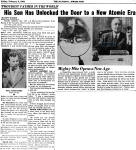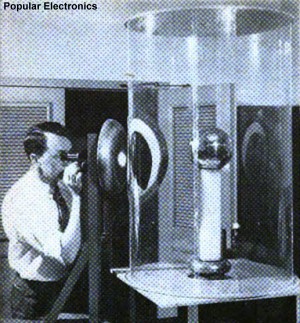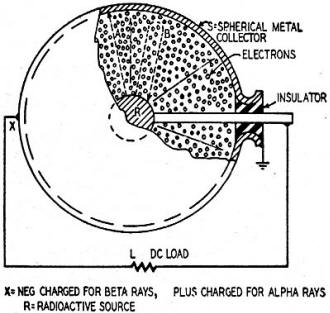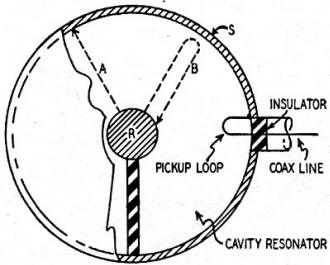|
February 1953 Radio-Electronics
 [Table of Contents] [Table of Contents]
Wax nostalgic about and learn from the history of early electronics.
See articles from Radio-Electronics,
published 1930-1988. All copyrights hereby acknowledged.
|
 Dr. Linder's patented AC and DC generators
exploited alpha (proton) and beta (electron) particle emissions from radioisotopes contained
within. The device is basically a metallic sphere concentric to an enclosed mounting
platform for polonium (α particle emitter), phosphorous
(β particle emitter),
or similar elements. With just a gram of radioactive material, the charge which accumulates
on the outer sphere generates a very high voltage (~1 MV) driving a low current
(~1 mA). Georg Ohm's work tells us that is equivalent to 1 kW of power - quite
a lot for a fairly compact device. Dr. Linder envisioned multiple atomic generators
combined in series and/or parallel to obtain the required power. No mention was
made of the effective internal resistance, which would ultimately determine the terminal
voltage when connected to a load. After all, a 1 megavolt battery would not be of much
use in a smartphone (to be invented half a century later) or flashlight. Dr. Linder's patented AC and DC generators
exploited alpha (proton) and beta (electron) particle emissions from radioisotopes contained
within. The device is basically a metallic sphere concentric to an enclosed mounting
platform for polonium (α particle emitter), phosphorous
(β particle emitter),
or similar elements. With just a gram of radioactive material, the charge which accumulates
on the outer sphere generates a very high voltage (~1 MV) driving a low current
(~1 mA). Georg Ohm's work tells us that is equivalent to 1 kW of power - quite
a lot for a fairly compact device. Dr. Linder envisioned multiple atomic generators
combined in series and/or parallel to obtain the required power. No mention was
made of the effective internal resistance, which would ultimately determine the terminal
voltage when connected to a load. After all, a 1 megavolt battery would not be of much
use in a smartphone (to be invented half a century later) or flashlight.
An article appeared in the February 5, 1954, edition of The National Jewish Post
that mentions a man named
Paul Rapport who worked with Dr. Linder on this device. Included
is a photo of RCA chairman David Sarnoff along with a small "atomic battery"
that exploited the principle. As far as I can determine, these devices never found their
way into production, most likely due to the requirement for radioactive material.
It is possible to legally purchase small quantities of radioisotopes (see
United Nuclear Scientific Equipment & Supplies), although maybe not
concentrated enough to power a useful atomic battery. Rumor has it that a suitable quantity
of polonium-210 might be available in some UK cafeterias where
expatriate KGB agents eat lunch.
Electron emission from eaterless cathodes of radioactive phosphorus
By H. W. Secor

Dr. Ernest G. Linder with atomic generator.

Fig. 1 - Linder atomic d.c. generator.

Fig. 2 - Generator for high frequencies.
Dr. Ernest G. Linder, research physicist with the Radio Corporation of America, has
taken out a patent (No.
2,598,925) for the direct production of electric current from atomic
sources.
In its simplest form, the Linder atomic generator consists of an evacuated metal chamber,
in Fig. 1, in which is mounted a radioactive substance R, such as polonium. Electrons
from the radioactive substance strike the metal shell S and build up an electric charge
on it. If a load L is connected between the radioactive cathode and the metallic shell
anode, current will pass through it and do useful work.
The emitter, or cathode, of this generator may be either positive or negative, depending
on the radioactive element. If it is polonium, it will radiate alpha particles, and the
collecting shell will be charged positively. If radioactive phosphorus is used, beta
particles (electrons) are radiated, and the charge on the metal shell is negative.
As much as two kilowatts of energy may be produced by such an atomic-electric generator.
This value is based on the assumption that 1 gram of radioactive phosphorus, occupying
but 1/2 cubic centimeter, will emit about two milliamperes of electric current. If the
average energy of emission is 1,000,000 volts, the electric energy amounts to 0.002 amp
x 1 megavolt, or 2,000 watts (2 kw).
Radioactive phosphorus has a half-life period of about 14 days, so the current and
power would decrease exponentially to one-half their initial values in that time. Possibly
in the near future some simple means will be devised for replenishing the radioactive
material in the electric generators periodically.
Radioactive phosphorus is a pure beta-ray emitter, which becomes stable after emission.
This material is suitable for use as electronic power sources, since it emits no gaseous
reaction products and therefore is quite suitable for vacuum applications, Dr. Linder
states.
In practice it will be possible to modify the atomic-electric generator units or connect
them in series or parallel (or series-parallel) groups so that the desired voltage and
current values can be obtained. With the a.c. generator the voltage can easily be reduced
by a transformer.
The impedance of the atomic electric generator is determined by the characteristics
of the charged particle emitting substance. A d.c. generator of the type described is
suitable for systems requiring high voltage and low power capacity. If large-power generators
are to be built, the charged particle element may be cooled by circulating water or a
forced air draft.
An a.c. Generator
Fig. 2 discloses that the a.c. unit is similar to the d.c. generator. One distinct
advantage of the a.c. generator is that it is particularly well suited to the generation
of radio-frequency energy; the collector electrode S may be dimensioned to resonate at
the desired frequency. If the radioactive source R emits negatively charged beta particles,
these will charge the tuned electrode S to a high negative potential, as indicated by
dotted arrow A. (An insulated rod supports the radioactive source element R as shown.)
After the electrode S attains the maximum potential of the beta particles, additional
particles are reflected back toward the source R, as arrow B indicates. As the collector
electrode is resonated at the desired radio frequency, the reflected electrons oscillate
back and forth between the source R and the electrode S, setting up an oscillating electric
field within the resonant collector.
To abstract
r.f. energy from this oscillating field, a pickup loop may be used as shown in Fig. 2.
A coaxial cable C may conduct the r.f. current to the load. The operation is similar
to that of the reflex velocity-modulated oscillator, or to the older Barkhausen-Kurz
oscillator.
In a recent interview Dr. Linder stated that he could not discuss his atomic-electric
generators in detail, nor disclose for what purpose they are to be used, as this matter
is bound up in military security. This general outline is presented here, however, because
of the unique operating principles of these newest types of electric generators.
Posted July 25, 2018
|












